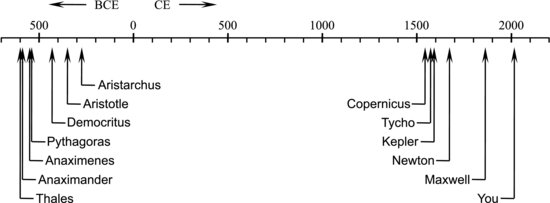3.4 Adolescence – Revolution!
Looking through the history schoolbook of my upper teens, most of it covers the doings of kings, generals and other people of power. The occasional digressions from this theme mostly deal with developments in the arts, sometimes in technology and, more rarely, in science. Out of about four hundred pages, only two are bestowed on what is sometimes called the Great Scientific Revolution. In my book, this turning point in our history goes under the more modest title “Scientific Advances”. I recently found that I, as a pupil, had put these two pages within parentheses, along with a penciled note of my history teacher's recommendation: “never mind this”.
Today, the remnants of the political intrigues in my history book mainly consist of new names and borders of nations. Although history's perpetual wars had the direst possible consequences for the people who had to endure them, the lasting effects on our present lives are limited. Regardless of the outcome of the Thirty Years’ War, for example, people living in catholic and protestant parts of Europe now enjoy similar health and living standards. Considering the radical effects that the scientific revolution has had, and still has, on our everyday lives, the outcomes of the political schemes of days gone by are dwarfed in comparison to the achievements of the scientists of the renaissance. We are greatly indebted to them and I wonder why many history teachers miss this point. I venture to think that it is only a matter of disinterest in science. For those who, like I, never learned about the Great Scientific Revolution, here is a quick recapitulation of one of the most wide-ranging developments ever to occur in human thinking. It loosely follows Koestler's [4] account. At the end of this chapter we will also discuss how it has changed our lives, but let's start at the beginning.
During the Middle Ages, Aristotelian physics and astronomy had become part of the official doctrine of the church, which had grown into a significant political force. As its power was believed to emanate from the highest possible quarters it was surely advisable not to question its authority. As a result, the scientific authority of Aristotle remained unchallenged. But throughout this period the Arabs had preserved the heritage of other Greek thinkers. Eventually, their long forgotten texts began slowly finding their way back to Europe. It is in the wake of this rediscovery of ancient ideas that the Great Scientific Revolution began [4]. The story begins with a Polish canon called Nicolas Koppernigk, better known under his latinized name Nicolaus Copernicus, who left his homeland to study in Italy around the year 1500. Here, he came into contact with both Pythagorean writings and ancient astronomical ideas, most notably the heliocentric theory of Aristarchus of Samos. These ideas stayed with him throughout his entire life and he elaborated them into an astronomical system in his book On the Revolutions of the Heavenly Spheres. In this, his only scientific work, he puts the earth adrift with the other planets around the sun, which he puts at the center of the universe. The Copernican system is shown in Figure 3.3. Knowing from the start that these were deeply inappropriate ideas he delayed the publication some thirty years. The first copy of the book arrived from the printer only hours before his death in 1543. His suspicions were confirmed: the book was to remain on the church's list of prohibited books until 1758.
Figure 3.3 A schematic representation of the Copernican system. It has the sun at the center and places the orbits of the then known planets around it, in the correct order.
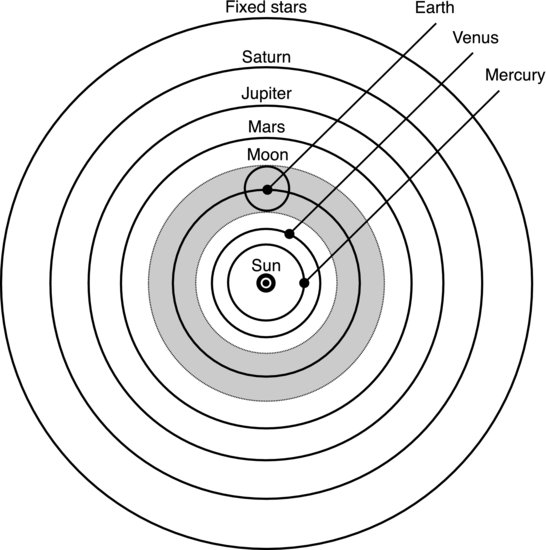
There is a popular notion that Copernicus instantly gets things right, that his book takes astronomy out of the medieval darkness and puts it in the modern era in one single leap. But his theory is not without problems. It is still dictated by ancient, preconceived ideas. The planets are still moving uniformly in circular orbits, the only thinkable motion of a heavenly body. Throughout the Middle Ages it had become standard practice to add epicylces to the orbits whenever the Ptolemaic system did not fit the astronomical observations. Copernicus also uses epicycles to iron out the wrinkles that arose from the fundamental errors that were still present in his system. Still, his system was fundamentally more correct and that made it simpler than the Ptolemaic one. Less patching up was needed to cover up the errors [2]. Copernicus’ main contribution to the development of science was to revive the great idea of Aristarchus of Samos and to make it accessible by publishing it in his book. He did not make many astronomical observations of his own but relied almost exclusively on Ptolemy's data. Theoretically he was reusing most of the ancient ideas [4].
The person who made the crucial contribution to the revolution of science was a German school teacher named Johannes Kepler. He began thinking about Copernicus’ universe while still a theology student during the 1590s. For him, the central sun was a symbol of God, the source of heat, light, and the force that drives the planets round their orbits. He also favored the Copernican system because it was geometrically simpler than the Ptolemaic one. Kepler too was heavily influenced by Pythagorean thinking and was to build his own model of the universe around the five Pythagorean solids. The influence is also evident in his later idea of a universe governed by musical harmonies. While being a teacher in the Protestant School in Graz, Austria, he was riddled by questions about the universe that seem completely meaningless to us. Why were there only six planets? (In his days no planets were known beyond the orbit of Saturn). Why were the distances between the planets and the sun what they were? Why did they move at their particular velocities? He made endless attempts to solve these problems.
Eventually, while giving a geometry class, he had an epiphany. He had drawn an equilateral triangle and two circles on the blackboard, as illustrated in Figure 3.4. One circle was inscribed in the triangle, the other was circumscribed around it. In a flash it occurred to him that the ratio of the two circles was the same as that of the orbits of Saturn and Jupiter. There seemed to be a geometrical structure to the cosmos! Though he failed in applying this idea to the other planets he felt that he was on to something. As two-dimensional polygons could not be matched to the planetary orbits he shifted his interest to three-dimensional shapes. The reason that there are only six planets, he thought, must be that the five Pythagorean solids determine the intervals between the orbits. And, surprisingly, he found that the solids fitted the orbits. Or at least they seemed to fit, more or less [4].
Figure 3.4 When Kepler drew this figure on the blackboard it struck him that the ratio of the two circles was the same as that of the orbits of Saturn and Jupiter.
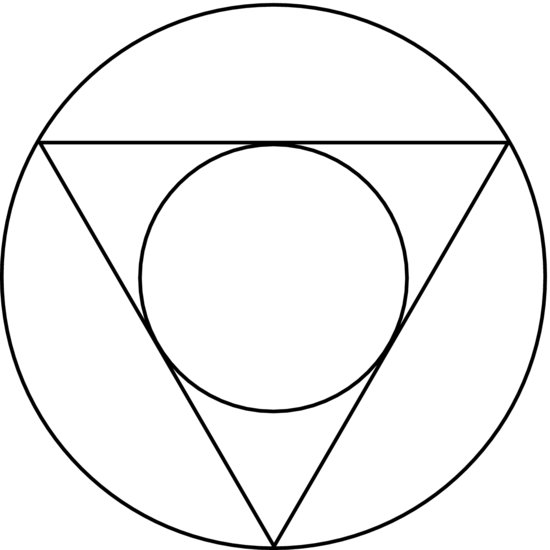
At the age of 25. Kepler published his innovative model of the cosmos in Mysterium Cosmographicum. In the first part of the book he works out a “principal proof” that the planetary spheres are framed in the five perfect solids. After this argument, based on preconceived ideas and divine inspiration, something remarkable happens in the text. The five solids, he says, is only an hypothesis that needs to be backed up by observational data. “If these do not confirm the thesis, then all our previous efforts have doubtless been in vain” [4]. In one leap he jumps from vague metaphysical speculation to the position that the truth is to be determined by observation of the real world: from the Pythagorean track back to the spirit of the Ionians. Like the Sleeping Beauty, the Ionian approach to science wakes up after being dormant for almost two millennia. This leap put Kepler in an intellectual dilemma, as he was soon forced to conclude that the data and the model did not match. Was there a problem with the model, or were Copernicus’ data to blame? Enamored with his great idea, which he thought had unlocked the grand mystery of the cosmos, he preferred to blame the data. To obtain better observations, Kepler set his hopes on Tycho Brahe.
Tycho, a contemporary of Kepler, was a Danish a nobleman who had originally been destined for aristocracy. Luckily for us, an astronomical event intervened. In his early teens he witnessed a partial eclipse of the sun that would change his life entirely. The fact that the eclipse had been predicted made a deep impression on him. How was it possible to foresee events in the heavens? He decided to become an astronomer and his genius manifested itself in the design of the most advanced astronomical instruments that the world had seen before the invention of the telescope.
At age 26, Tycho made a discovery that was to establish his reputation as the leading astronomer of his time. He was walking from his uncle's alchemy laboratory one evening when he suddenly saw a star brighter than Venus where no star had been before. His unique instruments allowed him to determine that the new star was much further away than the moon. This was a direct contradiction of the Aristotelian doctrine that changes could only occur in the region below the moon and that the sphere of the fixed stars was invariable. Tycho published the discovery in his first book De Nova Stella, which has given us the word “nova”. It is still used to describe a class of exploding stars although, technically, Tycho's star was a supernova.
Tycho was an eccentric character. For example, he kept a tame elk at his estate. In place of his nose he wore a golden prosthetic, as he had lost his own nose in a student duel over who was the better mathematician. In his youth, he studied at many universities all around central Europe and finally considered settling in Basel. However, word of his fame reached King Frederick II, who decided to entice him to return to Denmark. In 1576, the king sent a royal order for Tycho to come and see him at once and made him an offer that he could not refuse: the entire island of Hven in the Øresund strait, along with means to build a castle and observatory there. He was also offered a regular income that was among the highest in Denmark. He accepted and built the Uraniborg Castle on the island, the first building ever built with astronomical observation as its primary design criterion. It was a grandiose edifice and the only thing missing in it was the tame elk. While being dispatched to the island the animal had spent a night in a mainland castle, where it had wandered up the stairs and had too much beer to drink. As a sad result it had stumbled in the stairs, broken a leg and died [4].
As time went by, Tycho's manners made him ever more unpopular on Hven. His relationship with the next king, Christian IV, did not develop well and his income was decreased. Being used to a cosmopolitan lifestyle, Tycho also became restless on his remote island. As the circumstances changed his wanderlust took over and he eventually left for Prague, where he became Imperial Mathematicus to the Emperor Rudolph II [4].
It was at this time that Kepler set out to meet him. Due to religious persecution of protestants in Graz, foreboding the infamous Thirty Year's War, Kepler was forced to leave Austria. He headed for Prague to see Tycho, only to find that he would have to struggle more with Tycho's eccentric character than with the data that he had longed to get to work with. Instead of giving Kepler full access to the data, Tycho disclosed them to him piecemeal. He was not inclined to just give his life's work to a much younger scientific competitor. But some time later he was taken seriously ill and, on his deathbed, he bequeathed his observations to Kepler [3].
Eventually, Kepler was forced to realize that his theory of the five Pythagorean solids was no more supported by Tycho's data than Copernicus’. He understood that a model based on circular orbits could not explain the planetary motions. By shifting from circular orbits to elliptic ones he got a much better match with the data. In time, Tycho's observations let Kepler formulate his three laws of planetary motion. They state that the planets move in elliptical orbits with the sun in one focus and that they move faster when they are closer to the sun. The last law establishes a relationship between the length of a planet's year and its mean distance from the sun. In these laws the Pythagorean and Ionian traditions merge. Observed facts finally take precedence over speculation and preconceived ideas. On the other hand, the mathematical worldview of the Pythagoreans is justified. The numerical structure of the observations provided the key to understanding the world [3]. With his three laws, Kepler takes an intellectual leap out of the medieval deadlock that had brought developments in physics and astronomy to a standstill. He set us on the path of using exact observations to develop exact scientific theories. Still, his laws are purely descriptive. Though exact, they do not explain the planetary motions. Kepler speculated that the planets were propelled in their orbits by invisible spokes emanating from the rotating sun. This is a step forward from the older idea that angels pushed them round their tracks, but not a big one.
It is interesting to note that this crucial development in scientific thinking hinges on a combination of unlikely historical coincidences. Kepler was not well off and had Tycho remained in Denmark he could not have afforded to visit him. He would probably not have gone to Prague either, if he had not been forced from Graz by religious persecution. Apparently, positive things may sometimes come from such afflictions. Furthermore, these coincidences occurred in the nick of time, since Tycho had only 18 months to live when Kepler arrived in Prague. After Tycho's death, Kepler succeeded him as Imperial Mathematicus [4].
Kepler's celestial mechanics described the motions in the heavens. Meanwhile, in Italy, Galileo developed the terrestrial mechanics, describing motions of objects here on earth. This is an interesting story in itself, as Galileo was a pioneer in elaborating the experimental method, without which modern science would be a hopelessly watered down version of itself. Galileo's approach to research is discussed in the next chapter, but before that we will take a look at the final step in the completion of the scientific revolution. This step was taken by Isaac Newton and consisted in merging the celestial and terrestial mechanics into a unified theory. He showed that he same laws that governed the motions of the planets governed the motions here on earth. This would constitute the end of Aristotle and the beginning of modern science.
The development goes back to 1666 when the great plague forced the closure of Cambridge University. The young Newton spent time at home in Woolsthorpe and, apparently, had time to think about a great deal there. The year is often called Newton's year of miracles, as he developed four seminal theories while waiting for the university to reopen. In Chapter 2 we briefly touched upon his theory of optics. The idea of universal gravity was another one. It is probably difficult for us to understand how courageous and grand that idea actually was. It states that every object in the universe, including you, attracts every other object with a force that decreases inversely with the square of the distance between them. This is indeed one of the most magnificent generalizations ever made by a human mind, linking everything to everything else in this cosmos in an unimaginably vast web of invisible interactions. Yet another of his seminal discoveries was differential calculus, the indispensable mathematical tool for attacking this and many other problems that were to be solved in physics over the years to come [4]. As we have mentioned, Democritus had been stumbling close to discovering this method two thousand years before Newton, but now the time seemed to be ripe for it.
The idea of universal gravity was sparked when Newton saw an apple fall from a tree outside Woolsthorpe manor. Figure 3.5 shows a tree that is said to be propagated from this very tree. Tradition says that he saw the moon in the sky at the same time, which made him wonder if the force that pulled the apple towards the earth also held the moon in its orbit. He knew about Galileo's work on projectiles and equated the Keplerian orbit of the moon with the Galilean orbit of a projectile, constantly falling towards the earth but failing to reach it due to its high forward speed. If a projectile was fired from a high mountain, he reasoned, it would be deflected from its forward path by the earth's attraction, following Galileo's parabolic trajectory. The higher the initial velocity of the projectile, the farther from the mountain it would land. As shown in Figure 3.6, exceeding a certain critical velocity it would return to the point from which it was fired. He imagined the projectile falling towards the earth at the same rate as the earth's surface curved away from it. Retaining its initial velocity it would thereby go on orbiting the earth just as the planets orbit the sun. In Koestler's words, Newton, by thought-experiment, created an artificial satellite nearly three hundred years before technology was able to implement it [4].
Figure 3.5 This apple tree is propagated from a tree that grew in the garden of Woolsthorpe Manor, from which they say the apple fell that inspired Newton's theory of gravity. The original tree is said to have died about 1815–1820. The photograph was taken in the Cambridge University Botanic Garden. © Öivind Andersson.
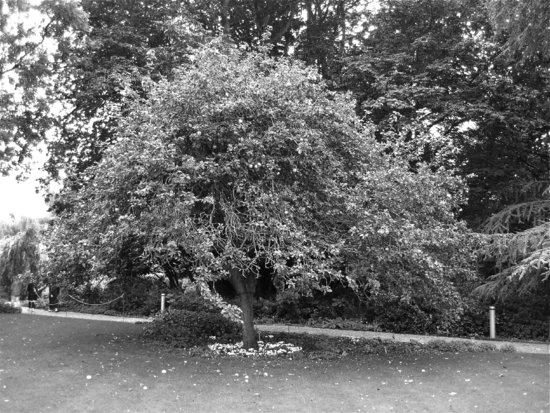
Figure 3.6 Newton's thought experiment. He creates an artificial satellite by firing a projectile with sufficient speed from a high mountain.
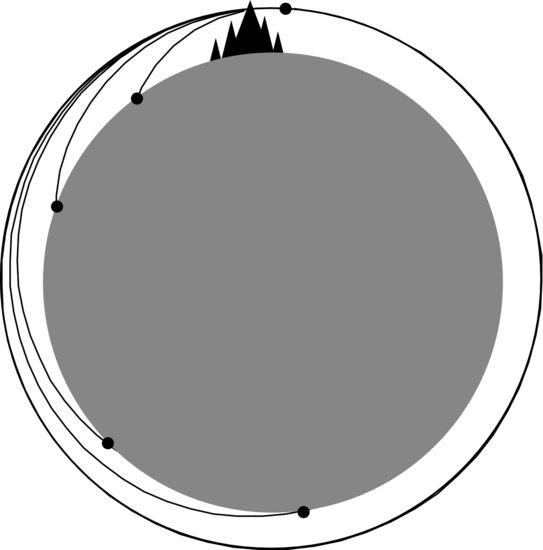
In addition to the theory of universal gravity, Newton developed a general theory of mechanics that described the motions of all objects, in the heavens as on earth. The whole theory was not published until 1687 in his most important work Mathematical Principles of Natural Philosophy, or Principia for short. The production of this work seems to have been sparked by another of history's peculiar coincidences. Edmond Halley, who is best known for calculating the orbit of the comet named after him, had engaged in a scientific wager that led him to Newton [5]. The wager concerned the explanation for the elliptic orbits of the planets. The question so absorbed him that he paid Newton an unannounced visit in Cambridge in 1684. He asked what Newton thought the planetary orbits would be like if they were attracted to the sun by a force following the inverse square law. Newton immediately answered that they would be elliptic. Amazed at the answer, Halley was eager to find out how he could know this. “Why”, said Newton, “I have calculated it” [5]. Unfortunately, he could not find his notes there and then, but he soon sent Halley a manuscript where he mathematically derived Kepler's three laws from the inverse square law of gravity. After an extended period of concentrated work, Principia emerged. In it, Newton set out his three famous laws of motion and derived from them the new mechanics that applied to every object in the universe. From his law of gravity it directly followed that no angels or spokes were needed to pull the planets around their orbits. All that was needed was the inverse square law.
There it was. The die was cast. Physics had become a mature, quantitative science, able to explain natural phenomena. It was a model for other sciences to follow. This was the beginning of the remarkable scientific development that still continues in our day. To put it into perspective, a timeline is provided in Figure 3.7.
Figure 3.7 Timeline for the characters introduced in the chapter.
